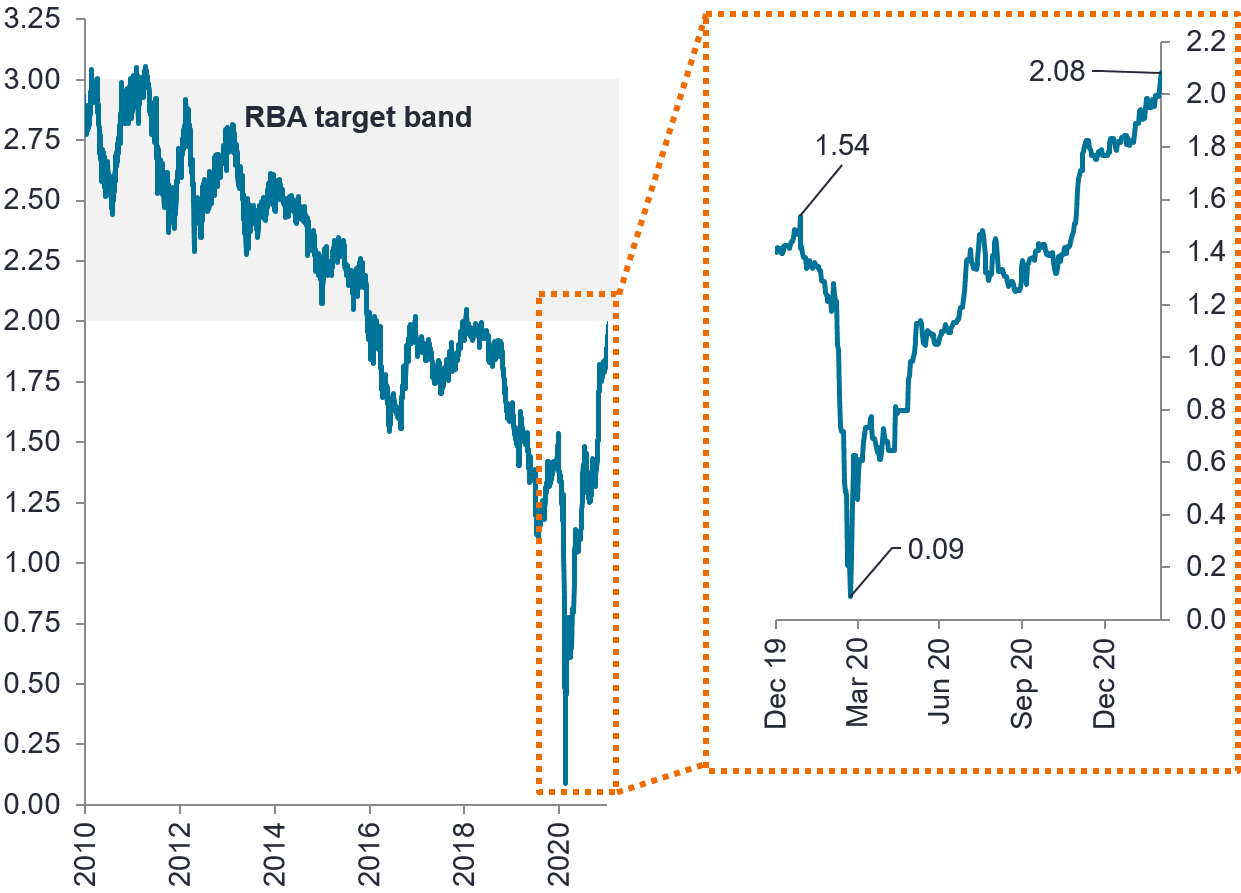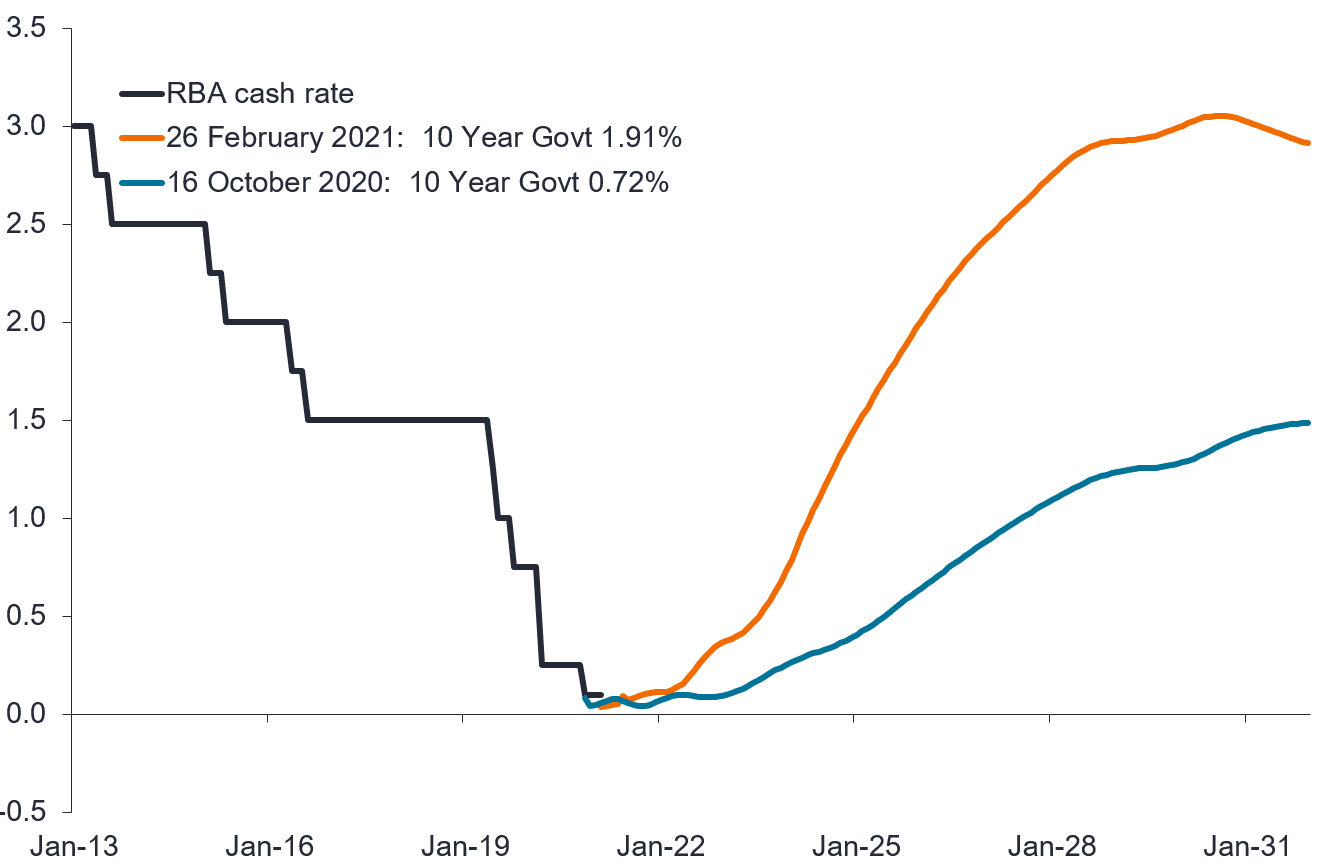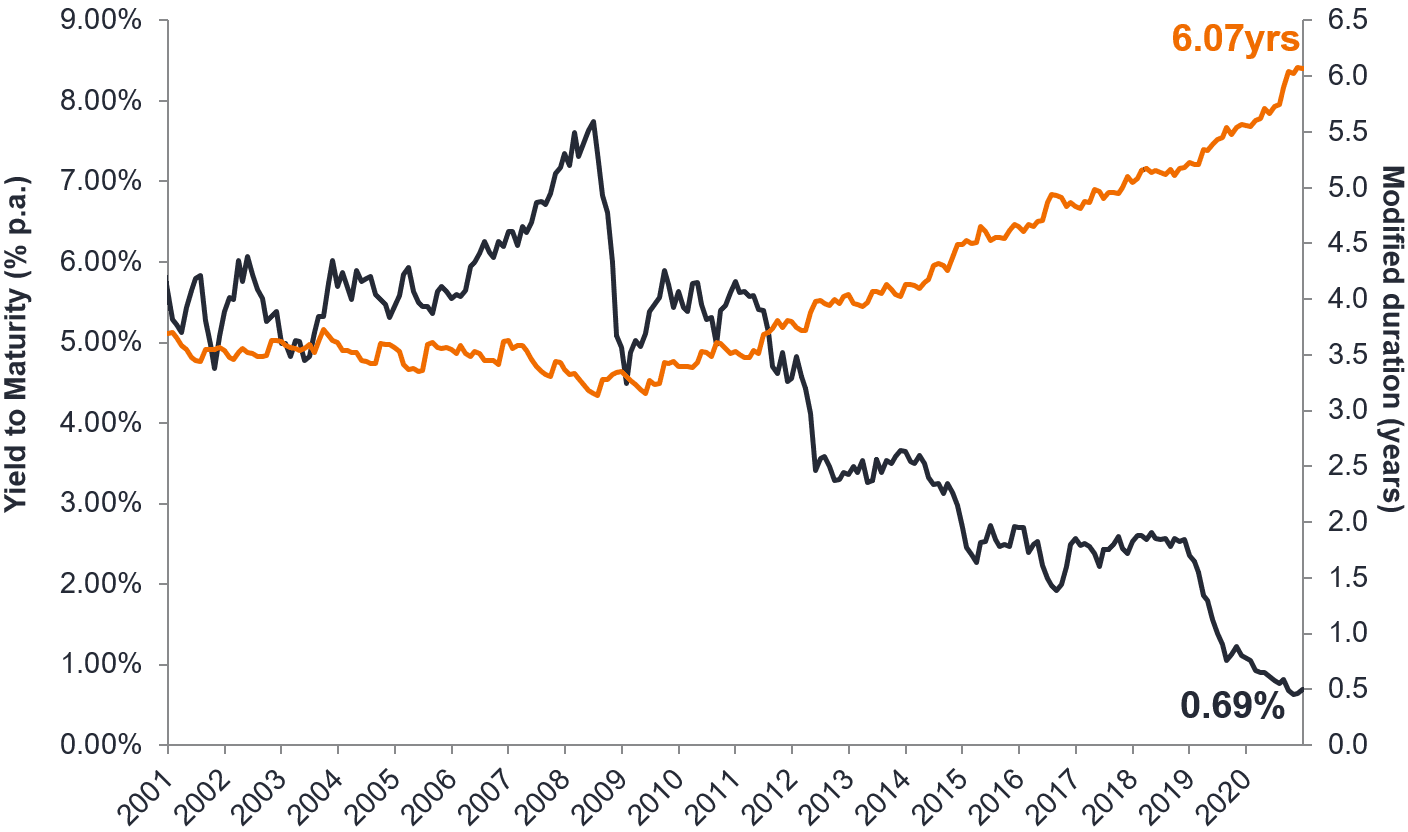Inside the bond market sell-off
Over February the Australian bond market1 was down approximately 3.5%, suffering its biggest negative monthly return since 1983. In combination with its negative return in January, this episode essentially wipes 80% of the bond market’s 2020 returns. Meanwhile, the 10 Year Australian Government bond yield has almost tripled since the lows experienced in 2020.
While only the rates market has been affected so far, in our view this could extend into risk assets (such as equities, high yield and investment grade credit) if central banks don’t intervene in a coordinated fashion to avoid a ‘taper tantrum’ style sell-off.
The ingredients for a bond market sell-off have been brewing for some time, and while hard to predict the turning point, as active managers we must be poised to re-position our portfolios and identify investment opportunities.
The three forces responsible
1. Rising inflation expectations:
- There has been a meaningful lift in inflation expectations over the past quarter resulting from positive sentiment around the post COVID-19 recovery and reflation.
- This has been largely driven by vaccination programs getting underway and central banks’ and governments’ commitment to supporting economies back out of the crisis.
- The rapid turnaround is depicted by the 10-year breakeven inflation rate shown in Chart 1 below. Inflation expectations are many times higher than the low point experienced in March 2020 and have now crept up into the Reserve Bank of Australia’s (RBA) inflation rate target.
Chart 1: Australian 10-year breakeven inflation rate (%)

Source: Bloomberg, ABS, Australian 10-year breakeven inflation rate to 4 March 2021.
2. Rising cash rate expectations:
- In Australia, cash rate expectations suggest an RBA cash rate of 3% by late 2028. As at 26 February, with three- and 10-year Australian Government bond yields at 0.127% and 1.91% respectively, there is an embedded expectation that cash rates will rise very quickly, surpassing pre-COVID monetary policy settings into ‘tight’ cash rates.
- To illustrate the shift in cash rate expectations, the chart below depicts the market’s pricing of the future path of cash rates on 26 February 2021 (orange curve), which is nearly three times higher than the market pricing back in October 2020 (blue curve).
Chart 2: Australian implied OIS forward 1m cash rate (%)

Source: Janus Henderson Investors, Bloomberg, monthly to February 2021, spot 26 February 2021.
- Interest rate risk (or duration), which is the sensitivity of bond markets to movements in bond yields, is a key risk for fixed interest investors to manage. The pre-conditions for adverse outcomes from the bond market (1) had been brewing for a while given it is featuring a potent combination of record high levels of duration and record low bond yields. In general terms, and for illustrative purposes only, the effect of six years of duration essentially means that, even a 1.0% rise in bond yields would result in a 6% decline in capital for index investors.
Chart 3: Yield to maturity and modified duration on the Bloomberg AusBond 0+ Yr Index

Source: Janus Henderson Investors, as at 31 December 2020. Index: Bloomberg Ausbond Composite 0+ Yr Index. Note: Past performance is not a reliable indicator of future performance.
3. Question marks over central bank commitment:
- Despite the asset purchase programs and dovish rhetoric from central banks, markets are pricing in an earlier return to the RBA tightening monetary policy than the 2024 conditional commitment they’ve made.
- Markets are now challenging the central banks on whether they will stay the course with forward guidance and yield curve control (YCC) measures over the next three years.
How we are navigating the turmoil
Effectively navigating the more volatile rising rate environment at the key turning points will be vital given the magnitude of interest rate risk (duration). Ultimately, as yields rise, we believe it is worth taking some duration risk to capture higher yields, especially if markets overshoot.
Higher bond yields when cash rates are anchored at close to zero present very steep yield curves and the opportunity for investors to participate in both the yield and roll-down effect that adds to performance.
Today a 10-year risk free government bond, if nothing happens in markets over the next year, can deliver a return that’s at least twice that of a five-year major bank floating rate corporate bond (2). These are exactly the type of opportunities active managers wait for even if some volatility in the near-term needs to be tolerated. One will only know after the fact whether the strategy went too early or too late.
The team have also been focusing on capital preservation strategies to protect against a breakout in inflation expectations.
Below is an overview of our investment strategy:
Rates:
Duration:
- We have gradually bought into the weakening bond market, with the expectation of higher returns in the future.
- While a plausible case can be made for bond yields gradually lifting over the medium to long term, the recent sharp price action seems to have brought forward that theme too quickly.
- Buying duration early will necessarily bring some near-term drawdown in return, but one can rarely pick turning points and only in hindsight will it be obvious.
- Our focus is on having the largest active position at the turning point, as it will be too late to position after markets have turned.
Inflation protection:
- Our sizeable allocation to inflation linked bonds has largely served the purpose of protecting portfolios against the market’s expectation of a sharp lift in inflation. However, the best time to own inflation protection is when others don’t want it or are not thinking about it, and that time is now gradually passing.
- As such, we have taken some profit through the sale of some of our holdings of government inflation linked bonds, though we have retained some exposure in order to reduce the impact of inflation expectations rising even higher should they break out to the upside.
Spread sectors:
Having participated in the meaningful rally of spread sectors, we feel prudent to take some profit while valuations are at peak levels in the post-COVID market rally.
Semi-government debt:
- We have more than halved our semi-government bond position amid dissipating relative value.
Credit protection:
- We have added some credit protection (through credit default swaps) as a means of more quickly reducing spread sensitivity to tail risk events.
Investment grade credit:
- We have reduced some investment grade credit in order to more selectively participate in key primary market debt issuance.
High yield:
- We have reduced holdings of high yield credit.
We are intentionally still exposed to credit markets, but the above provides some room for risk taking should markets become unstable.
This year is shaping up to be one where active interest rate strategies, including taking advantage of higher yields, may overshadow excess returns from spread sectors. Accordingly, our strategies will emphasise this from time to time as prevailing market conditions offer investment opportunities. While we expect some volatility and drawdown, near-term volatility presents an opportunity for active managers. Ultimately, higher bond yields restore the defensive characteristics and create better value for the asset class.
Learn more
Stay up to date with all our latest views but clicking the follow button below, and you'll be the first to read all our wires.
Footnotes
(1.) Australian Bond Market as measured by the Bloomberg AusBond Composite 0+ Yr Index.
(2). Based on no change to the current bond yield of 1.91% for 10-year Australian Government bonds and the estimated yield of an Australian five-year major bank floating rate notes of 0.45% (as at 26 February 2020).
(3). The above are the Portfolio Managers’ views and should not be construed as advice. Sector holdings are subject to change without notice.
.png)
.png)